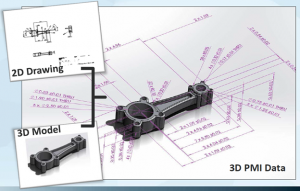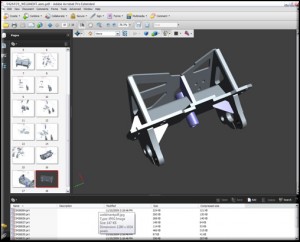
At the end of December I attended for the first time the “Model-Based Enterprise Summit.” I heard different and conflicting things about the Summit. However, since I was very intrigued about Model-Based Enterprise (MBE) methodology, I decided it was time for me to attend the event to broaden my understanding.
For those not familiar with MBE you can navigate to their website for more information. Here is the formal definition:
MBE is an integrated and collaborative environment, founded on 3D product definition shared across the enterprise, enabling rapid, seamless, and affordable deployment of products from concept to disposal.
Just like any other methodology, the definition describes something I think we all want and need. The question to me was how does MBE achieve “an integrated and collaborative environment” and how can it be used in our industry? This was my goal of attending this Summit.
When I arrived and reviewed the agenda I was very surprised that there were 2 talks on the first day specifically related to the shipbuilding industry, with more on the following days. One of the presentations I really enjoyed was from Ben Kassel from NAVSEA who very well described the unique challenges in the shipbuilding industries.
My key take-away
Model Based Definition (MBD)
At the core of MBE is the product definition package called the Model Based Definition (MBD). The MBD contains all the information (3D Model, 3D/2D Views, annotations, PMI, GD&T, etc.) needed to fully define a product.
With this technical digital package you will be able to view the model in 3D with all the properties annotated as well as have other views and information you require for your task at hand.
Traditionally (currently 😉 ) we share model information using 2D drawings with possibly additional spreadsheets with the specific details of the components. The model based definition replaces these traditional disconnected drawings, documents and spreadsheets and combines them into one complete package.
Most MBD’s utilize modern 3D technologies such as 3D PDF, JT or Navisworks which allow some very rich and interactive tools to examine the MBD model.
In my opinion the two main benefits of the MBD are:
- The MBD provides a vastly better way of communicating information with the capability to visually interact with your model. This results in faster and more accurate exchange of information.
- Having all the information contained in one package means there is a lesser (not eliminated) possibility of using the wrong information.
Sharing information across enterprise
Having a single digital technical package does allow easy sharing across the enterprise which also includes suppliers. There were several presentation on how companies were using the MBD to communicate more effectively with their suppliers and owners. Most of the communication seemed to be unidirectional and not bi-directional.
There is no standard MBD
There are many different vendors creating their own MBD versions. This was one of the biggest disappointments to me as I initially thought there was a standard that everyone was using. This standard would enable a better ecosystem around using MBD.
It at least was nice to know almost all (or maybe even all) vendor MBD versions use some Application Protocol (AP) of STEP. However, there is still a requirement to use a specific vendor’s viewer. This does limit its usefulness, in my view.
How effective is the MBD for collaborative communication?
Without having a standard MBD I am not fully sure of how well this will be as a collaborative exchange. If both sites have the same tools I think it can be a successful solution but that will not be the common case. As mentioned there is usually a STEP file contained in the package but it will not contain all the information you may need for collaborating on a design. For example, it does not contain the parametric and associative relationships needed if one site desires to modify a geometric detail.
Also, in the definition of MBE it specifically states “collaborative environment” but I did not get this from the presentations I attended. Most of the presentations were about a one-way push of data which I will argue is not collaborative though could be part of a collaborative system.
Related to shipbuilding
I went to this summit to get a better idea of how it can be used effectively in the shipbuilding industry and I do feel I have a good understanding about MBE benefits. However, I still have more researching and discussions to do.
Most companies using MBE are focused on manufacturing equipment items and I am not sure how this will translate to building larger structures such as ships or rigs. I had numerous discussions with several attendees about this and I still feel I do not have a good grasp on how it can be fully used.
Where does cloud fit into the picture?
It was interesting that the only one who mentioned “Cloud” was Alex Viana from United States Naval Facilities Engineering Command (NAVFAC). I think there is some real potential for cloud in an MBE.
Worst part of the conference
No coffee in the auditorium.
Closing remarks
Many of the key concepts of MBE are already done by many companies and even SSI’s clients. They may not be calling it MBE but the core of their workflow is utilizing the MBE principles.
If we consider the formal definition of MBE stated previously, ShipConstructor can totally be part of an MBE. Clients are currently generating many digital technical packages for stakeholders throughout their organization containing all the information required for the their specific task.
An example is creating a digital technical package for the CNC Profile operator which contains:
- A file which can directly be fed into the CNC Profile machine with no additional processing;
- An image and documents of the resulting profile to support traditional workflows and familiarity;
- A rich 3D view of the profile with all attributes allowing the operator to quickly view the profile currently being processed as well as the ability to interrogate the details of the profile if required.
Having no standard MBD’s does limit the use of it in a truly collaborative environment. As mentioned, it can be part of a collaborative environment, but it just is not an enabling methodology.
The concept of sharing a file (MBD) is still something I am not sure I like. It is better than the current strategy of multiple files but once we transfer a file it should be considered out-of-date. This might be the reality we live in today. However, I do feel that this will need to change. “How?” you ask. That is what we need to figure outJ. Some of my previous blog posts talk about a Zero File CAD/CAM system.
Are Zero File CAD/CAM Systems the Future?
Is ShipConstructor a Zero File (file-less) solution?
I will continue to learn more about MBE and see if it or at least portions of its methodology can be included into our industry. I welcome any comments and corrections to any of my interpretations and observations I mentioned in this blog post.
Original image from PLM Group



Post Comments
Thanks for sharing Denis – which neutral standards were discussed. Any mentioning of ISO 15926 which is a standard in the process-like industries
There were no presentations on that standard but it did come up a few times during questions and during coffee. The conference seemed more focused on the digital technical package and not how these will able to be exchanged. This was more what I was looking for.
There was a presentation on the newly released ISO 10303:AP242, you can see the presentation here: http://www.nist.gov/el/msid/upload/16_aBarnardFeeney.pdf. It was interesting to hear how long it took and how they plan on improving the duration between modifications since if standards take multiple years to be revised then standards will not be the solution which industry adopts.
There were no presentations on that standard but it did come up a few times during questions and during coffee. The conference seemed more focused on the digital technical package and not how these will able to be exchanged. This was more what I was looking for.
There was a presentation on the newly released ISO 10303:AP242, you can see the presentation here: http://www.nist.gov/el/msid/upload/16_aBarnardFeeney.pdf. It was interesting to hear how long it took and how they plan on improving the duration between modifications since if standards take multiple years to be revised then standards will not be the solution which industry adopts.